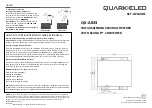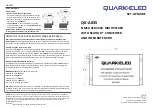
8
MEASURE DC or AC mV VOLTAGE
•
Turn the rotary knob to “mṼ, press the FUNC button and switch to
DC or AC voltage function.
•
Insert the red probe into the “ ” socket and the black probe into
the “COM” socket.
•
Connect the probe to the measured circuit (connect to the circuit
under test in parallel).
•
Read the measurement result on the screen.
• Note
: In AC voltage function, press the
Hz%
button to measure
the frequency and duty ratio of the AC voltage source. Please refer to ‘Measure
Frequency’ for details.
•
The AC voltage value measured by using this instrument is true RMS (root mean
square). For sine wave and other waves (no DC offset), such as square wave,
triangle wave and step wave, these measurements are accurate.
•
The maximum range for AC/DC mV (60/600mV) voltage measurement is 600mV,
the input impedance is up to 10
Ω and any measurement of weak signals should
not be attenuated.
V
¡ £¡ £
V
11
WARNING
•
Do not allow measurement of any voltage higher than DC 1000V or AC 750V
RMS, otherwise it may cause damage to the instrument, electric shock or
personal injuries.
•
Do not apply voltage exceeding DC 1000V or AC 750V RMS between the
common terminal and the earth, otherwise it may cause damage to the
instrument, electric shock or personal injuries.
MEASURE FREQUENCY & DUTY RATIO
•
Turn the rotary knob to “Hz%”, press the
Hz%
button and switch
between frequency and duty ratio (in AC voltage or AC current
shift frequency and duty ratio can also be measured)
•
Insert the red probe in “ ” socket and the black probe in “COM”
socket.
•
Connect the probe to the measured circuit (connect to the circuit
under test in parallel), measure the frequency or duty ratio.
•
Read the measurement result on the screen.
Hz
¡ £¡ £
WARNING
•
Do not allow measurement of any voltage higher than DC 1000V or AC 750V
RMS, otherwise it may cause damage to the instrument, electric shock or
personal injuries.
•
Do not apply voltage exceeding DC 1000V or AC 750V RMS between the
common terminal and the earth, otherwise it may cause damage to the
instrument, electric shock or personal injuries.
WARNING
•
Do not apply voltage exceeding DC 1000V or AC 750V RMS between the
common terminal and the earth, otherwise it may cause damage to the
instrument, electric shocks or personal injuries.


































